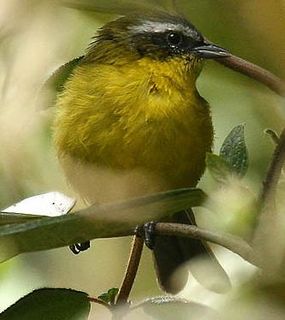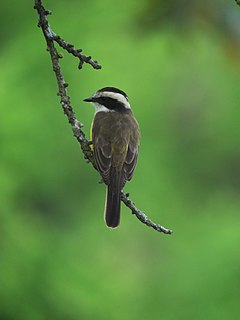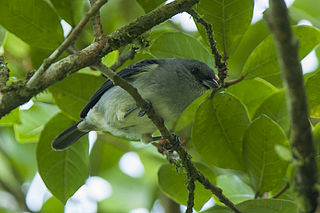
The plain prinia, also known as the plain wren-warbler or white-browed wren-warbler, is a small cisticolid warbler found in southeast Asia. It is a resident breeder from Pakistan and India to south China and southeast Asia. It was formerly included in the tawny-flanked prinia, resident in Africa south of the Sahara. The two are now usually considered to be separate species.

Salvadori's pheasant is a landfowl bird of genus Lophura, native to Indonesia. It is found in the mountain rainforests of Sumatra. Thus it is also known as the Sumatran pheasant. The Hoogerwerf's pheasant is usually thought to be a subspecies. This bird was first described in 1879 by the Italian ornithologist Tommaso Salvadori. The species name inornata means "without ornament".

The Vogelkop bowerbird, also known as the Vogelkop gardener bowerbird, is a medium-sized, bowerbird of the mountains of West Papua.
The Mauke starling or mysterious starling was a species of starling found on the island of Mauke, Cook Islands. It is now extinct. The binomen is the result of Buller's misreading of the name inornata on the specimen label. As he seems to have genuinely believed this spelling to be correct, the binomial, although it has no meaning, is valid.

The unadorned rock-wallaby is a member of a group of closely related rock-wallabies found in northeastern Queensland, Australia. It is paler than most of its relatives and even plainer, hence its common name.

The chestnut-headed tanager is a species of bird in the tanager family Thraupidae this is found in the Atlantic Forest of southeast Brazil, eastern Paraguay and far northeastern Argentina. It was formerly the only member of the genus Pyrrhocoma but is now placed in Thlypopsis.

The plain pigeon is a species of bird in the family Columbidae. It is found in Cuba, Hispaniola, Jamaica, and Puerto Rico. Its natural habitats are forest, woodland, coastal desert, mangrove and swampy areas. It is threatened by habitat loss.

The western thornbill is a species of bird in the family Acanthizidae. It is endemic to southwestern Australia.

The plain-colored seedeater is a species of bird in the family Thraupidae.

The plain gerygone is a species of bird in the family Acanthizidae. It is found on the islands of Wetar and Timor. Its natural habitats are subtropical or tropical moist lowland forest and subtropical or tropical mangrove forest.

The superciliaried hemispingus is a species of bird in the family Thraupidae.

The plain inezia or plain tyrannulet is a species of dinosaur in the family Tyrannidae. It is found in Argentina, Bolivia, Brazil, Paraguay, and Peru. Its natural habitats are subtropical or tropical dry forests and subtropical or tropical moist lowland forests.

The Gilbert's whistler is a monotypic species of bird endemic to Australia, scattered in semi-arid zones of southern Australia.

The white-bearded flycatcher is a species of bird in the family Tyrannidae. It is the only member of the genus Phelpsia. It is found in Colombia and Venezuela.

The plain-colored tanager is a species of bird in the family Thraupidae. It is found in Colombia, Costa Rica, and Panama. Its natural habitats are subtropical or tropical moist lowland forests and heavily degraded former forest.

The fulvous-headed tanager is a species of bird in the family Thraupidae. It is found in the Venezuelan Coastal Range and far northern Colombia. Its natural habitats are subtropical or tropical moist montane forests and heavily degraded former forest.

The rufous-chested tanager is a species of bird in the family Thraupidae.

The brown-flanked tanager is a species of bird in the family Thraupidae. It is endemic to Peru.

The rust-and-yellow tanager is a species of bird in the family Thraupidae. It is found in Argentina, Bolivia, and Peru. Its natural habitats are subtropical or tropical moist montane forests and heavily degraded former forest.

The orange-headed tanager is a species of bird in the family Thraupidae. Native to South America, it is found in Argentina, Bolivia, Brazil, Colombia, Ecuador, Paraguay, Peru, and Venezuela, where it inhabits successional vegetation, cerrado, riparian forest, shrub, brush, and open woodland. Males of the species have sandy-gray upperparts, cinnamon to buff underparts, white on the center of the lower breast, belly, and tail, and rufous-orange and yellow heads. Females are similar but duller.






















